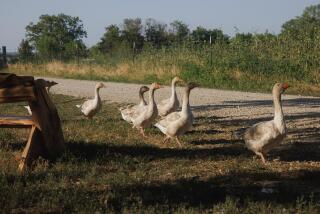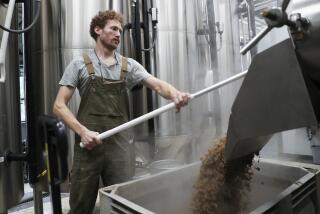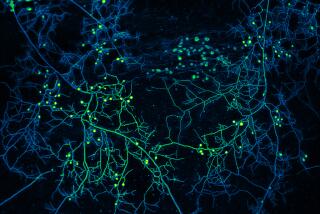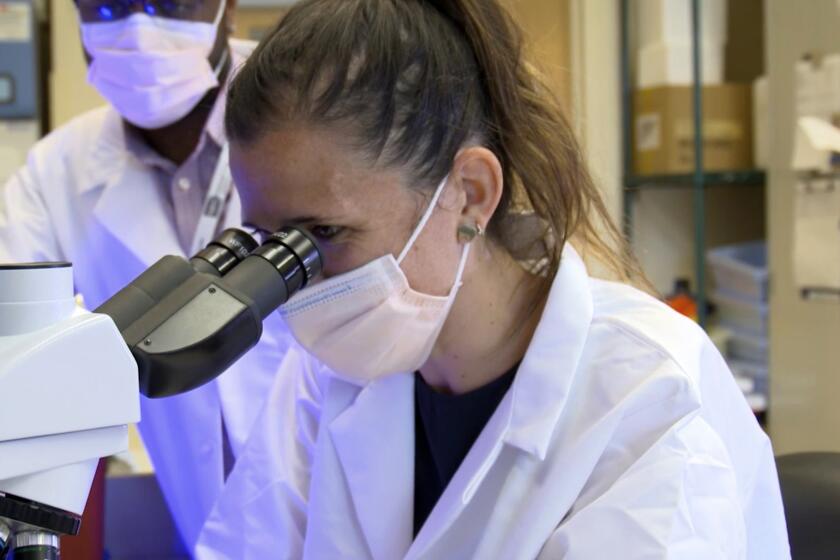Q&A:: Why tiny microbes may be a big factor in how climate change unfolds
- Share via
Climate change is about big things: melting ice sheets, rising seas, the feverish temperature of the planet.
But scientists say it’s also about little things — namely, microbes.
Everywhere you look on Earth, you’ll find these single-celled organisms making a living. And in the process, they produce and consume greenhouse gases including carbon dioxide, methane and nitrous oxide, helping to control the concentration of these planet-warming substances in the atmosphere. Collectively, they play an enormous role in regulating the climate.
They are also the glue that holds ecosystems together. They often form the base of the food web and perform critical duties, such as breaking down organic matter, recycling nutrients and photosynthesizing.
Like all life forms, microbes will feel the impacts of climate change. The way they respond could have huge implications for the rest of us. For instance, microbes will help determine whether natural sources of greenhouse gases rise or fall in a warming world. And they are key to ecological resilience in the face of environmental stress.
That’s why a group of scientists issued a consensus statement calling for more research on the topic in this week’s issue of Nature Reviews Microbiology. Ominously, they called it ”Scientists’ Warning to Humanity.”
The Times spoke with Victoria Orphan, a microbial ecologist at Caltech who helped write the statement, about why we shouldn’t overlook microbes.
Just so we’re all on the same page, what are microbes?
They have one cell, by definition. Most you can’t see with your naked eye. But as small as they are, they are incredibly powerful in terms of the types of chemistry that they can do.
Where do they live?
Everywhere. Basically, any place that we would consider habitable for us, we find microbes. And in places that we would consider too extreme for multicellular life, we also find microbes. They are really the champions of colonizing every possible livable space on the planet.
And what do microbes have to do with climate change?
Many microbes in the ocean photosynthesize just like plants. They are responsible for generating half of the oxygen in our atmosphere. At the same time, they are also pulling carbon dioxide from the atmosphere into the ocean and turning it into biomass. So they play a huge role as a sink for carbon dioxide, for example.
Methane is another important greenhouse gas. What about that?
Methane is largely cycled by microbes. We study one particular process in which two microorganisms collaborate to do this really challenging chemistry of oxidizing methane with sulfate. And they do this very effectively. We don’t know the numbers exactly, but the upper estimates are 80% of the methane in ocean sediments is consumed by this team of microorganisms before it reaches the atmosphere.
So, if these microbes weren’t working together, a lot more methane would be getting into the atmosphere?
That’s right. We’re concerned that there’s a lot of discussion about things like deep-sea mining of natural resources. We know so little about these deep-sea habitats. If we start destroying them, this may perturb the system and make these important biological filters less effective.
Have microbes been overlooked in how we think about climate science?
It depends on who you ask. Some scientists are acutely aware of the importance of microbes. But we need to get the word out to everybody else that this is really critical.
This is not just in the deep ocean, where I do most of my work, but in every single habitat. Microorganisms are basically determining how much greenhouse gases are emitted from these ecosystems, either as sources or as consumers of those gases.
Can you give an example of how microbes’ response to climate change could amplify the problem?
A familiar one is melting permafrost. Basically, you’re taking carbon-rich frozen sediments and you are thawing them. Microorganisms are feasting on this organic carbon and, as an end product of their metabolism, they are producing things like methane. It’s like taking a frozen dinner out of the freezer and thawing it — now it’s become edible.
There’s tremendous amounts of carbon in permafrost that has been stored for many thousands of years, if not longer. But all of a sudden it is being made available all at once. It’s not just the fact that this process is going on, it’s also the speed that then can throw systems out of balance.
Are there ways microbes can help?
I think there’s a lot of exciting potential for engineering microbes. But in order to apply this in an effective way, we really need to understand their full impact in ecosystems and how they respond.
My colleague Frances Arnold is sort of the champion for doing directed evolution and making all sorts of very interesting products and things that we never could have dreamed that a microbe could do.
What’s an example of a way microbes can help the climate?
Cows are a huge producer of methane. That methane is produced in their rumens from fermentation of grasses or corn. And this rumen is like a little ecosystem — just like studying deep-sea sediments. So there may be ways that we can better understand how microorganisms are working together to try to either minimize methane production from the start, or try to oxidize that methane before it’s belched out of the cow.
In the consensus statement, you warn that ”the impact of climate change will depend heavily on responses of microorganisms.” What do you want people to do with that knowledge?
I would like them to not only have an appreciation for the fact that microbes basically rule the planet and we are just, you know, kind of visiting, but also to value and understand the importance of putting in effort in researching this. We’re starting to get on that trajectory, but there still needs to be greater awareness of its importance.
Is there anything else you want us to know?
People have gone through this radical change from thinking that microorganisms were dangerous germs to embracing the microbiome. That’s really wonderful, because people really care about their well-being and health. How then do we translate that excitement and wonder to the natural world around us? I think that is the big challenge.
This interview has been edited for length and clarity.







